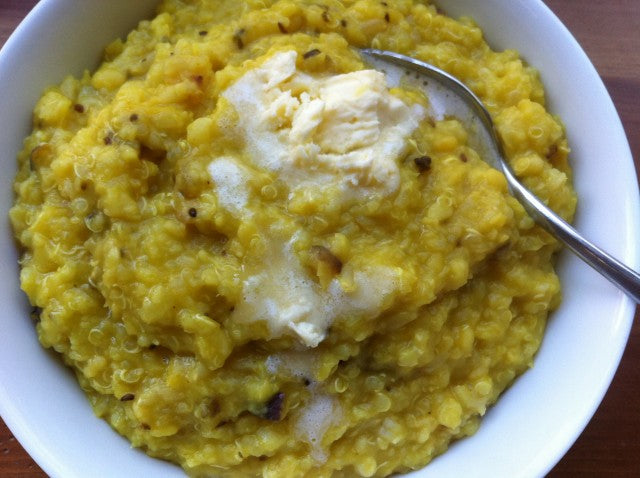October 31, 2012 2 Comments
This week, I needed a little comfort. Any of us with connections to the East Coast did. It's been a totally hellish week. Of course nothing can compare to the poor people stranded in shelters or watching their homes and livelihoods disappear in a flash, but there are so many others that were also touched by Hurricane Sandy.
My brother and his family were holed up without power in Greenwich, Connecticut. My mom and dad are in King of Prussia, gearing to catch a flight to India this week. My best friend lives in an apartment building next to NYU Medical center. And the list goes on and on and on.
I almost got stuck too. I left for an event-filled week on Friday for New York, which started with an interview with Dr. Radio (Samantha Heller) on Sirius Radio that afternoon. Sunday, I was scheduled to a demo for Williams-Sonoma Columbus Circle when the craziness hit. My demo was cut short, my class for Monday night canceled, and I made the decision to get out. I would have stayed if it didn't mean getting stranded for a week without my kids, but it just didn't look good. Nor, did it feel right. It just felt ominous on Sunday. If you want to read about the experience, AP Newswire even covered my crazy trip.
The point is, I'm back in Chicago. Grateful to be safe. Grateful that everyone I know is safe and still riveted by the images coming across from New Jersey (where I spent most childhood summers) to Connecticut. And now - more than ever - I need a bowl of savory comfort.
In America, we have chicken noodle soup that seems to cure all ailments. In Indian cuisine, we have Kitchari. Directly translated, it means all mixed up - basically a one-pot meal of lentils and basmati rice cooked together with spices until all ingredients break down and blend together into a mix that's at once rich, creamy, and surprisingly delicious.
It's one of those meals that I suggest and my husband just rolls his eyes. No one really plans to eat Kitchari as a meal. It's usually made when you have a belly ache or fever - something easy on the digestive system that is at once healing and nutritious.
But, once made, it's surprisingly delicious, too. Why not make it more often?
My latest quest was to boost protein by subbing some rice with quinoa. I know some of you are new to quinoa, but you should absolutely get acquainted with it if you are looking for more plant-based sources of protein. The long and short of it is that quinoa is a seed (not a grain), that was eaten as a staple ingredient in South America. It is different than many other seeds and grains because it is a COMPLETE protein, providing all 9 amino acids, and one of the highest levels of protein for a plant-based ingredient. A 1/3 cup of cooked quinoa has been cited to have 160 calories, 2.5 grams of fat, 3 grams of fiber, and 6 grams of protein.
The beautiful thing is that it also cooks up just like rice. One part quinoa to 2 parts water. So, I tend to make my basmati rice by subbing half of it for quinoa. The family never knows the difference, and I know they are getting a layer of protein that they would not otherwise. It's a win-win.
You can do the same with your Kitchari. Watch out world. This is BIG!
Brown Rice-Quinoa Moong Dal Kitchari
Makes 8 cups
2 cups yellow lentils, moong dal
1/2 cup brown basmati rice
1/2 cup white or red quinoa
8 cups water (this might vary slightly)
3 tablespoons ghee or oil (I use grape seed)
1 teaspoon cumin seeds
1 teaspoon carom seeds, or ajwain
1 teaspoon turmeric powder
2 black cardamom pods (use green if you don't have black)
1/2 medium red onion, finely diced
2-inch piece ginger, peeled and grated or minced
1-2 cloves garlic, peeled and grated or minced
1-3 Thai green chiles (optional)
2 teaspoons coarse sea salt
1/2 teaspoon red chile powder or cayenne (optional)
fresh cilantro for garnish
1. In a deep saucepan, add lentils, rice, quinoa, and water.
Bring to a boil. Turn heat to medium-low and simmer for 25-30 minutes until all your ingredients soften and blend together. It will come together like the consistency of porridge. Once cooked, put the lid on the pan tightly and turn the heat off. Let the mixture sit until you complete the next step. Tip: of course you should rinse your ingredients. Quinoa is hard to rinse, though, because the seeds are so tiny they tend to wash away easily. I use a strainer like this to at least rinse everything once. You can also use white basmati rice if you prefer. I find the Patel Brothers brand of brown rice to be incredibly light and fluffy. For quicker cooking and less water evaporation, keep a lid on your pot, but keep the lid slightly ajar so that your water does not overflow. If you don't use a lid, keep in mind you might need to add more water towards the end of cooking. If you have a kettle handy, add boiled water so that you don't bring down your cooking temperature by adding cold water. Also, lentils sometimes create a foam when cooking. I just skim this off the top and discard it. 
2. Heat oil over medium-high heat in a separate sautee pan. Add cumin, carom, turmeric, and cardamom pods. Cook until the seeds turn a reddish brown and sizzle, about 30-40 seconds. Tip: This is a pretty quick process. Be careful not to step away. It's easy to burn the seeds and turmeric.
3. Add onion, ginger, garlic, and green chiles if using. Cook until the mixture slightly browns. Tip: This process is called tarka, or heating your oil, and infusing it with spices and key ingredients. If you want, add more chopped veggies including corn, carrots, or tomatoes. The possibilities are endless.
4. Take your cooked spiced tarka and add it to your lentil/rice/quinoa mixture. Mix well. Add salt, red chile pepper if using.
5. Remove whole spices like the cardamom, dole into bowls, garnish with chopped, fresh onions, cilantro, and regular or vegan butter and serve immediately piping hot. Tip: If this dish gets cold, it tends to thicken because of the rice and lentils. The best way to reheat it is slowly in a saucepan over medium-low heat. Add a little water to get it to the perfect consistency once again. Of course you might need to add a little more salt as well. 
Kids Speak: My kids were initially wary of eating this Kitchari, but once they took a taste they were completely hooked. Even Neha's friend, Paul, thought twice, but ended up getting seconds and thirds. Tip on feeding your kids kitchari: Just give them a tiny bit along with their regular meal. I usually start with just a tablespoon or two and then tell them all they have to do is taste it once or twice. If they 'hate' it, it goes off the menu for a week and then reappears later. I never give up, but I also don't force them to eat something they say they don't like. This dish, though, was a smash hit -- as you can see from the picture! 
November 01, 2012
My FAVORITE!! Cannot wait to make it – thank you!
Comments will be approved before showing up.


Maria
February 07, 2022
I made this but I subbed 400 ml of water with a can of full fat coconut milk and added an additional can of coconut milk as well. Also added 2 cups chopped tomatoes. WOW!!! My whole family loved this. It will surely be a staple from now on. Super incredibly filling, nutritious and delicious. Served with sliced cucumber, sometimes sliced avocado and green onions/ cilantro on top AND TOASTED COCONUT. To die for !